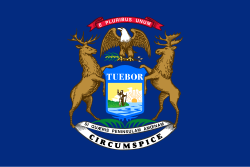A request that this article title be changed to Minor Michigan infantry units in the Civil War is under discussion . Please do not move this article until the discussion is closed. |
Minor Michigan Infantry Units of the American Civil War
Contents
- Stanton Guard, Michigan Volunteer Infantry
- Independent Company, Michigan Volunteer Infantry (Provost Guard)
- See also
- Notes
- References

The State of Michigan raised a pair of company-sized infantry units for the American Civil War.